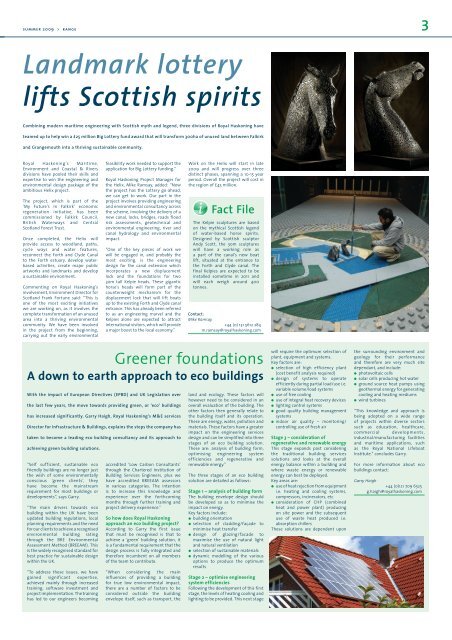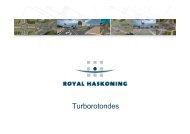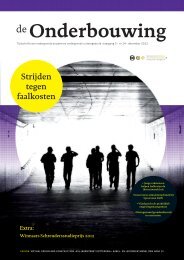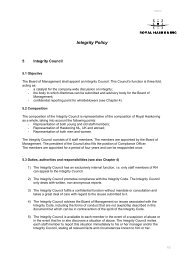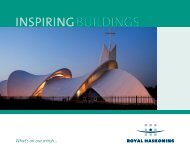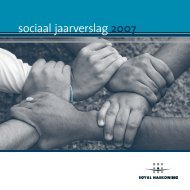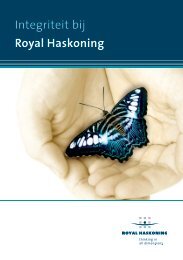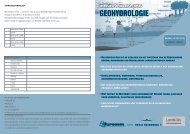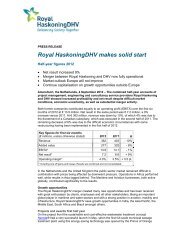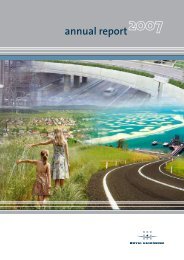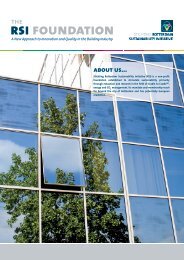Summer 2009 - Royal Haskoning
Summer 2009 - Royal Haskoning
Summer 2009 - Royal Haskoning
Create successful ePaper yourself
Turn your PDF publications into a flip-book with our unique Google optimized e-Paper software.
summer <strong>2009</strong> > range 3<br />
Landmark lottery<br />
lifts Scottish spirits<br />
Combining modern maritime engineering with Scottish myth and legend, three divisions of <strong>Royal</strong> <strong>Haskoning</strong> have<br />
teamed up to help win a £25 million Big Lottery fund award that will transform 300ha of unused land between Falkirk<br />
and Grangemouth into a thriving sustainable community.<br />
<strong>Royal</strong> <strong>Haskoning</strong>’s Maritime,<br />
Environment and Coastal & Rivers<br />
divisions have pooled their skills and<br />
expertise to win the engineering and<br />
environmental design package of the<br />
ambitious Helix project.<br />
The project, which is part of the<br />
‘My Future’s In Falkirk’ economic<br />
regeneration initiative, has been<br />
commissioned by Falkirk Council,<br />
British Waterways and Central<br />
Scotland Forest Trust.<br />
Once completed, the Helix will<br />
provide access to woodland, paths,<br />
cycle ways and water features,<br />
reconnect the Forth and Clyde Canal<br />
to the Forth estuary, develop waterbased<br />
activities, create major public<br />
artworks and landmarks and develop<br />
a sustainable environment.<br />
Commenting on <strong>Royal</strong> <strong>Haskoning</strong>’s<br />
involvement, Environment Director for<br />
Scotland Frank Fortune said: “This is<br />
one of the most exciting initiatives<br />
we are working on, as it involves the<br />
complete transformation of an unused<br />
area into a thriving environmental<br />
community. We have been involved<br />
in the project from the beginning,<br />
carrying out the early environmental<br />
“Self sufficient, sustainable eco<br />
friendly buildings are no longer just<br />
the wish of some environmentally<br />
conscious ‘green clients’, they<br />
have become the mainstream<br />
requirement for most buildings or<br />
developments”, says Garry.<br />
“The main drivers towards eco<br />
building within the UK have been<br />
updated building regulations, local<br />
planning requirements and the need<br />
for our clients to achieve a recognised<br />
environmental building rating<br />
through the BRE Environmental<br />
Assessment Method (BREEAM). This<br />
is the widely recognised standard for<br />
best practice for sustainable design<br />
within the UK.<br />
“To address these issues, we have<br />
gained significant expertise,<br />
achieved mainly through increased<br />
training, software investment and<br />
project implementation. The training<br />
has led to our engineers becoming<br />
feasibility work needed to support the<br />
application for Big Lottery funding.”<br />
<strong>Royal</strong> <strong>Haskoning</strong> Project Manager for<br />
the Helix, Mike Ramsay, added: “Now<br />
the project has the Lottery go-ahead,<br />
we can get to work. Our part in the<br />
project involves providing engineering<br />
and environmental consultancy across<br />
the scheme, involving the delivery of a<br />
new canal, locks, bridges, roads flood<br />
risk assessments, geotechnical and<br />
environmental engineering, river and<br />
canal hydrology and environmental<br />
impact.<br />
“One of the key pieces of work we<br />
will be engaged in, and probably the<br />
most exciting, is the engineering<br />
design for the canal extension which<br />
incorporates a new displacement<br />
lock and the foundations for two<br />
30m tall Kelpie heads. These gigantic<br />
horse’s heads will form part of the<br />
counterweight mechanism for the<br />
displacement lock that will lift boats<br />
up to the existing Forth and Clyde canal<br />
entrance. This has already been referred<br />
to as an engineering marvel and the<br />
Kelpies alone are expected to attract<br />
international visitors, which will provide<br />
a major boost to the local economy.”<br />
Work on the Helix will start in late<br />
<strong>2009</strong> and will progress over three<br />
distinct phases, spanning a 10-15 year<br />
period. Overall the project will cost in<br />
the region of £45 million.<br />
Fact File<br />
The Kelpie sculptures are based<br />
on the mythical Scottish legend<br />
of water-based horse spirits.<br />
Designed by Scottish sculptor<br />
Andy Scott, the 30m sculptures<br />
will have a working role as<br />
a part of the canal’s new boat<br />
lift, situated at the entrance to<br />
the Forth and Clyde canal. The<br />
final Kelpies are expected to be<br />
installed sometime in 2011 and<br />
will each weigh around 400<br />
tonnes.<br />
Contact:<br />
Mike Ramsay<br />
+44 (0) 131 5612 284<br />
m.ramsay@royalhaskoning.com<br />
Greener foundations<br />
A down to earth approach to eco buildings<br />
With the impact of European Directives (EPBD) and UK Legislation over<br />
the last few years, the move towards providing green, or ‘eco’ buildings<br />
has increased significantly. Garry Haigh, <strong>Royal</strong> <strong>Haskoning</strong>’s M&E services<br />
Director for Infrastructure & Buildings, explains the steps the company has<br />
taken to become a leading eco building consultancy and its approach to<br />
achieving green building solutions.<br />
accredited ‘Low Carbon Consultants’<br />
through the Chartered Institution of<br />
Building Services Engineers, plus we<br />
have accredited BREEAM assessors<br />
in various categories. The intention<br />
is to increase this knowledge and<br />
experience over the forthcoming<br />
months through further training and<br />
project delivery experience.”<br />
So how does <strong>Royal</strong> <strong>Haskoning</strong><br />
approach an eco building project?<br />
According to Garry the first issue<br />
that must be recognised is that to<br />
achieve a ‘green’ building solution, it<br />
is a fundamental requirement that the<br />
design process is fully integrated and<br />
therefore incumbent on all members<br />
of the team to contribute.<br />
“When considering the main<br />
influences of providing a building<br />
for true low environmental impact,<br />
there are a number of factors to be<br />
considered outside the building<br />
envelope itself, such as transport, the<br />
land and ecology. These factors will<br />
however need to be considered in an<br />
overall evaluation of the building. The<br />
other factors then generally relate to<br />
the building itself and its operation.<br />
These are energy, water, pollution and<br />
materials. These factors have a greater<br />
impact on the engineering services<br />
design and can be simplified into three<br />
stages of an eco building solution.<br />
These are: analysis of building form,<br />
optimising engineering system<br />
efficiencies and regenerative and<br />
renewable energy.”<br />
The three stages of an eco building<br />
solution are detailed as follows:<br />
Stage 1 – analysis of building form<br />
The building envelope design should<br />
be developed so as to minimise the<br />
impact on energy.<br />
Key factors include:<br />
l building orientation<br />
l selection of cladding/façade to<br />
minimise heat transfer<br />
l design of glazing/facade to<br />
maximise the use of natural light<br />
and natural ventilation<br />
l selection of sustainable materials<br />
l dynamic modelling of the various<br />
options to produce the optimum<br />
results<br />
Stage 2 – optimise engineering<br />
system efficiencies<br />
Following the development of this first<br />
stage, the levels of heating cooling and<br />
lighting to be provided. This next stage<br />
will require the optimum selection of<br />
plant, equipment and systems.<br />
Key factors are:<br />
l selection of high efficiency plant<br />
(cost benefit analysis required)<br />
l design of systems to operate<br />
efficiently during partial load/use i.e.<br />
variable volume/load systems<br />
l use of free cooling<br />
l use of integral heat recovery devices<br />
l lighting control systems<br />
l good quality building management<br />
systems<br />
l indoor air quality – monitoring/<br />
controlling use of fresh air<br />
Stage 3 – consideration of<br />
regenerative and renewable energy<br />
This stage expands past considering<br />
the traditional building services<br />
solutions and looks at the overall<br />
energy balance within a building and<br />
where waste energy or renewable<br />
energy can best be deployed.<br />
Key areas are:<br />
l use of heat rejection from equipment<br />
i.e. heating and cooling systems,<br />
compressors, incinerators, etc<br />
l consideration of CHP (combined<br />
heat and power plant) producing<br />
on site power and the subsequent<br />
use of waste heat produced i.e.<br />
absorption chillers<br />
These solutions are dependent upon<br />
the surrounding environment and<br />
geology for their performance<br />
and therefore are very much site<br />
dependant, and include:<br />
l photovoltaic cells<br />
l solar cells producing hot water<br />
l ground source heat pumps using<br />
geothermal energy for generating<br />
cooling and heating mediums<br />
l wind turbines<br />
“This knowledge and approach is<br />
being adopted on a wide range<br />
of projects within diverse sectors<br />
such as education, healthcare,<br />
commercial developments,<br />
industrial/manufacturing facilities<br />
and maritime applications, such<br />
as the <strong>Royal</strong> National Lifeboat<br />
Institute.” concludes Garry.<br />
For more information about eco<br />
buildings contact:<br />
Garry Haigh<br />
+44 (0)121 709 6525<br />
g.haigh@royalhaskoning.com


